Volleyball drills for technique defense / passing / digging / diving / reception
Trainer throws ball to defender, there are 3 rows of attackers at position 2, 3 and 4 ready. SV chooses a striker. Attackers pay attention to their run-up and arms.
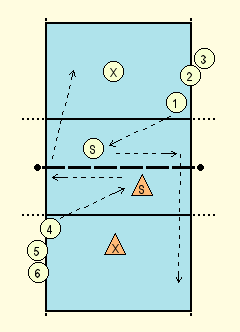
The purpose of the exercise is twofold: the defender must learn to 'read' where the attacker is going to hit and the attacker must look where the defence is before hitting.
We work with two regular playmakers, on both sides of the field a row of attackers on the left-for position. And two defenders, who may choose where they position themselves on the field. A defender has to defend the attack 10 times, preferably a nice pass, but touching is enough. If the attacker hits the net or leaves the field, that also counts. And the attackers may only smash, no prick balls! After the attack, the attacker retrieves the ball and joins the other row. The attacker who defends the ball at the 10th time takes the place of the defender. The defender will then of course attack.
Necessary:
- 8 - 10 players
- enough balls
If there are less players, the exercise can also be done, but then on one side. The attacker retrieves the ball and joins the same line.
The blocker joins in, indicates where he is going to block and the mid-back goes to his place.
3 gives setup on 1 and 1 attacks on 2. 2 defends to 3, 3 gives setup on 2 and 2 attacks on 1, 1 defends on 3 and it starts all over again.
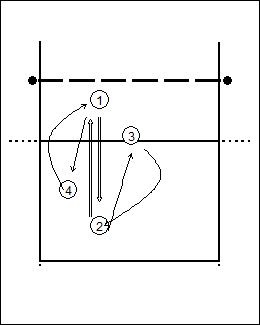
- the coach is at the net.
- 1 person in the field.
- the trainer throws difficult balls
- the person in the field has to touch the balls 3 times in a row.
- if he/she does not do this, you continue until he/she succeeds.
- The rest of the players stand around the field to catch the balls and put them back in the cart.
One scapegoat is appointed, this scapegoat must try to catch the other players within the yellow lines.
- Has the ticker ticked 3 players? Next ticker!
- The whole volleyball field is the playing field.
- In the middle of the field the net hangs about 40 cm above the ground (do not tighten the bottom line for safety reasons).
- The players and tickers can dive under the net to get to the other side of the court.
- the players stand side by side on the back line
- From the defensive position, one step forward is taken,
- The players stand side by side on the back line and the upper body is moved forward as low as possible.
- The protruding leg must be bent so that the body remains low.
- In the meantime, the arms remain stretched out in front of the body.
- If the back of the player passes the front foot, the player will fall forward and the arms are placed side by side on the floor to catch the fall.
- While the hands are on the floor, the back must be drawn hollow and the body moves a little further forward.
- The intention is that the belly hits the ground first.
- After this the player stands again on the spot where he landed and repeats the exercise until the net is reached.
- Usually this can be done in 2 or 3 dives.
Play the ball underarm.
- Accent on foot position (wide and 1 leg before and after the pass)
- Arms straight and still when passing - right leg before and after the pass - step out on the left for the follow-up action
- Also use the knees
Two teams in the length of the field.
Pass the ball at the net 10 times at 6 mtr and the player at 6 mtr passes the ball back.
Coach each other when things are not going well and indicate whether the ball is good or not.
Sprawl trainingExplain the
sprawl. (gliding low over your forearm to catch the ball)
Start on your knees and make yourself long while sliding over your forearms.
If that goes well, let the group stand and do the same exercise while sitting low. This can still be a barrier for some players to continue You have to coach these players to get this technique right.
In the end they all go.
Then in groups of three hit the ball to practice.
- 1 hits (throws) the ball
- 1 does the sprawl
- 1 player catches the ball.
If this goes well you let the player on the 3mtr line start doing a split step backwards and do the sprawl forwards.
Note it is wise to have socks or long sleeves on with this exercise.
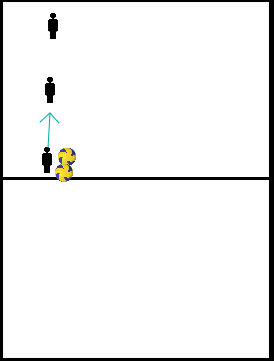
- A serves to B.
- B passes the ball to the playmaker, who then plays a high ball into the backfield.
- B defends this ball back to the playmaker, who then gives a setup for B.
- B attacks this setup.
After the attack, A takes B's place and B becomes a reserve. The playmaker stays.
The attackers use the left half of the court with one playmaker. The middle attackers and diagonal attackers use the right half with another playmaker.
Extension:
- After the service, A takes a second ball.
- After B's attack A throws this ball into the field.
- B plays this ball to the playmaker, the playmaker gives a setup.
- B attacks again.
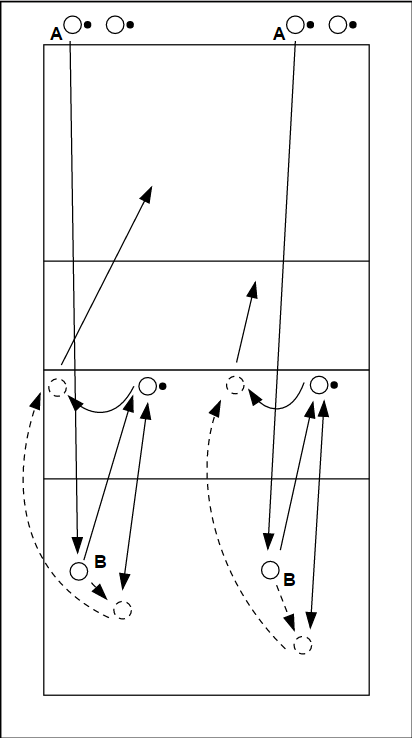
- 3 teams, per 3 teams 2 balls.
- 2 persons at the net - 4 meters apart - 1 person in the back (6 m).
- Pass 25 balls in high tempo.
- Accent on staying low
Apart from technique, communication is important in volleyball. And both aspects also apply to this exercise. And reacting adequately to situations that go differently than normal. In this kind of exercise you can see very well how different players are.
- We start with 5 minutes of serving for everyone.
- Then this exercise begins
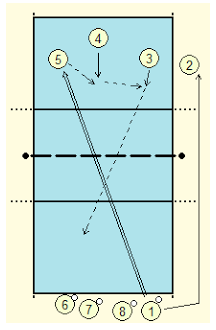
- Three players line up to pass (numbers 3, 4 and 5). Player 2 stands ready at the side of the same court. The other players are ready with the ball to serve on the other side.
- Player 1 serves the ball (and then immediately runs to where player 2 is already standing)
- A player passes the ball. Another player gives a setup. And the third player plays the ball over the net. All three players must play the ball, either a pass, or a setup, or an attack.
- Once the ball is over the net, the players turn: 2 goes into the court (where 3 was first) 3 goes to mid-back, 4 goes to the spot of 5 and 5 goes the serving spot of the other half.
- Then the next player can serve, on the drawing this is player 8. Etc.
- Team setup, when possible on two sides.
- 1 side serves the team
- team that receives service tries to score.
- After scoring 3 times, rotate 1 position.
Team setup side A, remaining players side B in two rows at position 2 and 4. Attacking the team.
Emphasis is on proper blocking and defense. In defence make sure you are low, on your front feet and move until the ball is hit.
Note: what are your agreements in defence with regard to the block?







